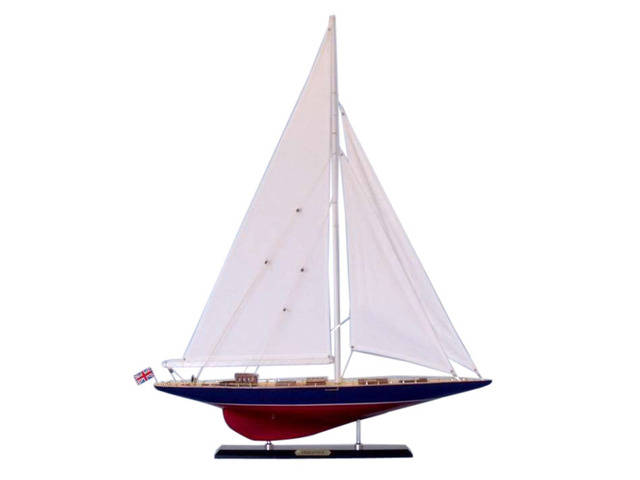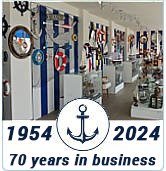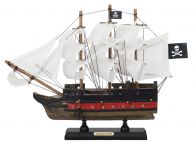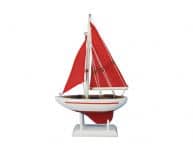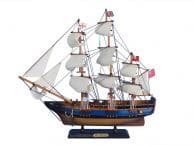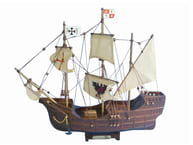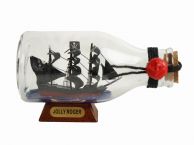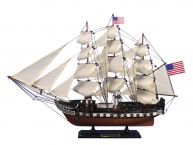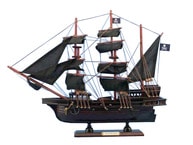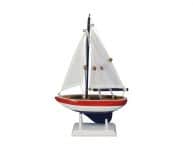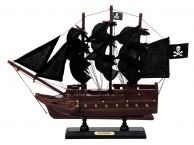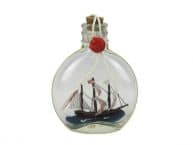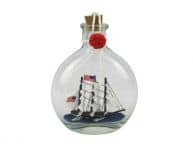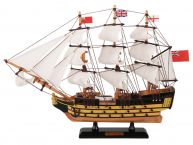|
|
Customers Also Shopped

|
|

|
Wooden Endeavour Limited Model Sailboat Decoration 35"
The J-class yachts are beloved symbols of extravagance from a bygone age, each designed and financed by a unique personality to compete in The America’s Cup. Looking back, we are left to wonder at the priorities of the people involved; how could they justify to themselves the expenditure required for a boat race during the height of the Great Depressionω Not to mention, these millionaires would rarely even leave themselves with a souvenir of this ultimate luxury; most J-class yachts were sold for scrap following the race. Today, we are left to marvel at the extraordinary series of events that was The America’s Cup from 1930-’37.
After the suspension of racing during World War II, its resumption in ‘58 featured smaller yachts, undoubtedly more affordable to field. This makes any surviving J-class yacht to be a rare, valuable historical artifact - exactly what the Endeavor is.
When it was constructed, The Endeavor was extraordinary for its design and technological innovation, and it remains so for being one of the only America’s Cup J-class yachts still intact.
History of the J-Class
The America’s Cup is a yacht race between the Americans and British, with both sides fielding a single vessel selected by winning qualifying races against similar models. Each nation then selects the fastest model and crew to compete on behalf of it for that year’s race. Of course, wooden sailboat racing isn’t only a contest for the crews of the model sailing yachts; it’s also a contest for its designers.
Just as with car racing, technology and innovation come to the forefront of wooden sailboat engineering, and as such, the rules continued to evolve about exactly how a particular yacht model could be constructed. For instance, both of the 1903 America’s Cup racing yachts (The Reliance and The Shamrock III) were so lopsided as to barely be seaworthy on stormy days. The yachts fielded by the Americans were particularly lopsided because they, unlike their British brethren, did not have to be seaworthy enough to actually sail to the racing site under their own power. The Americans, for reasons only wealthy yacht owners understand, could produce a yacht just seaworthy enough to not sink when sailing about in closed harbor regatta races.
A new set of rules came down in 1914 called “The Universal Rule” which established classes of racing yachts by the ratio of their length, displacement, and total area of their sails. Previously, length was the only criterion which mattered, which designers readily abused by putting excessive amounts of sail on yachts of those models. Now that these factors were accounted for, different classes of yacht were established by variable ratios of the aforementioned criteria. Several other ratios were then codified into yachts of ten different classes for single mast yachts: I through S. The America’s Cup race from 1930-’37 soon saw the J-class as the most desirable design criteria.
History of Thomas Sopwith
Thomas Sopwith, who financed and sailed the Endeavor for the 1934 America’s Cup, was a British millionaire and aviator who shares many parallels to the American icon Howard Hughes: both were born into wealthy families, had a keen engineering mind, entered into aviation during a major war, and fell subject to government criticism for profiteering in the aftermath of that war.
Sopwith, born in 1888, studied engineering in school and developed a passion for aviation early, winning the 1910 prize for longest flight (169 miles) from England to Europe, in three hours and forty minutes. He used the prize money to build the Sopwith School for Flying at Brooklands, going on to establish the Sopwith Aviation company two years later. Shortly thereafter, the world was plunged into The Great War, with the company being commissioned by the British government to manufacture biplanes - the most famous being the Camel, a single-seat fighter - for use in the war.
The punitive, anti-profiteering taxes following the war quickly bankrupted him, but Sopwith re-entered the aviation business with engineer and test pilot Harry Hawker and his Hawker Aircraft. Soon, Sopwith was flying high again, looking for new outlets for wealth and his engineering talents, and like so many others, turned to competitive yachting to scratch the (costly) itch.
History of the Endeavor
Sopwith, working closely with builders Camper and Nicholson, made the Endeavor the most advanced yacht of its day, featuring:
· a stainless steel hull and mast
· a quadrilateral genoa style front sail (meaning it would overlap the main sail)
· a twin clewed mainsail (an innovation still in use in the J classes of today)
· a larger and improved spinnaker sail
Its advantages allowed the Endeavor to easily best its British competition. It beat both the Shamrock V and Velsheda to earn the right to be the challenging yacht for the cup. It seemed Britain’s best hope was to wrest the Cup from the Americans. Unfortunately for Sopwith, his professional crew went on strike just before the race, after demanding a wage increase, which was denied. The Endeavor, now crewed by amateurs still less skilled than their American counterparts, proved the closest to the Cup in its era, but was alas defeated. The Endeavor instead went on to dominate British sailing until feared lost in ‘37 when a tow cable had broken, leaving her adrift at sea. While eventually found, she wouldn’t sail without extensive repair, and sadly entered a long period of neglect.
Laid up, and set to be sold for scrap, like so many of her siblings of the forgotten J-class, a strange intervention occurred, a sudden offer to purchase, just hours prior to her intended demolition. But it wasn’t enough. Regardless of why she was spared, she would still find herself lost to history, and decaying - eventually at the bottom of the river Medina, for which her owner sold the wreckage for a mere ten pounds. Patched up, so she could again stay afloat, she continued to slowly rot away, a far cry from the once glorified yacht which ruled the waves and competed in America’s greatest race.
Not until Elizabeth Meyer, an angel investor whose recent passion was to restore the great yachts via a five-year project. She undertook the labor of love in 1984, culminating in the brilliant day, when, after fifty-two years, most of which saw her abandonment and destruction, the Endeavor sailed again, the twenty-second of June, 1989. And she remains today one of the rare few J-yachts to survive the era.
 Handcrafted
Handcrafted Handcrafted
Handcrafted Handcrafted
Handcrafted Handcrafted
Handcrafted Handcrafted
Handcrafted Handcrafted Model Ships
Handcrafted Model Ships


